 Luxury cars make Asia premiere at Auto China
Luxury cars make Asia premiere at Auto China
 Versatile dog
Versatile dog
 Ni Ni covers BAZAAR JEWELRY
Ni Ni covers BAZAAR JEWELRY
 Cherry blossoms reach peak bloom in Washington D.C.
Cherry blossoms reach peak bloom in Washington D.C.
 Top Chinese fashion icons in foreigners' eyes
Top Chinese fashion icons in foreigners' eyes
 Asia's largest business aviation exhibition to be held in Shanghai
Asia's largest business aviation exhibition to be held in Shanghai
 World's top-rated luxury hotels
World's top-rated luxury hotels
 Wu Jing, Xie Nan to hold wedding on May
Wu Jing, Xie Nan to hold wedding on May
 London Cake International attracts tourists
London Cake International attracts tourists
 Let's dance in harmonic Shaanxi
Let's dance in harmonic Shaanxi
JINDO, South Korea, April 22 -- The relatives of the Chinese passengers aboard a capsized South Korean ferry were battered on Tuesday, as rescuers pulled out more bodies from the ill-fated ship.
"How could my child die like this?" the grieving mother of a male Chinese passenger who was confirmed dead murmured to herself again and again.
The bodies of her son and another Chinese male were recovered on Monday, more than 100 hours after the 6,825-ton "Sewol" submerged in icy water with a total of 476 passengers and crew aboard off South Korea's southwest coast on April 16.
In what could be South Korea's worst maritime disaster in two decades, at least 108 people have died, 194 others were still missing as of Tuesday afternoon.
Coast guards carried the bodies covered in white cloth from a boat to a tent on Jindo Island for identification, where their family members were waiting in anguish.
Although 174 people were rescued shortly after the ship sank, the chances of finding more survivors are becoming increasingly slim seven days after the disaster.
CHINESE VICTIMS
The two Chinese men were identified according to their ID cards. One of them was found in waters where the ferry sank, the other was recovered inside the ship, South Korea's coast guard said on Monday.
"Yes, that's my boy," the mother, who preferred not to be named, burst into tears at the sight of her son lying still on a stretch and wearing the same coat as he boarded the ill-fated ship.
The mother had received a text message from her son saying the ship was delayed due to thick fog.
The ship, en route from the port of Incheon to the traditional honeymoon island of Jeju, departed some two and a half hours later than scheduled.
The Chinese embassy has confirmed that four Chinese nationals -- two men, a woman and a schoolgirl -- were among the missing passengers aboard the ship.
Parents of the missing teenage girl also confirmed the news, but declined to say whether she has gotten South Korean citizenship.
Passengers aboard the ship included 325 students and 15 teachers from Danwon High School in Ansan, a Seoul suburb, which, according to the Chinese embassy, is home to many Chinese nationals.
In recent years, a growing number of Chinese arrived in South Korea, as Seoul eased visa restrictions and devised favorable policies to attract Chinese tourists.
In 2013 alone, 3.92 million Chinese visited South Korea, overtaking Japan for the first time. The Chinese words "youke," meaning visitors, was even included in Korean vocabulary.
FADING HOPE
Underwater search continued Tuesday as tidal currents became slower, focusing on the third and fourth floors of the five-story vessel where bodies and possible survivors were believed to be trapped.
Divers began entering and searching inside the submerged vessel from Monday, but the protracted rescue operation, hampered by chilly and murky waters, only led to a surge in death toll.
For the first five days since the disaster took place, divers had trouble with prying their way into the hull as the site of the accident was known for the country's second-fastest currents.
Five guideline ropes had been snaked into cabins and convenience facilities inside the ship, enabling divers to follow along the lines and get there much faster than before. It somehow helped with rescue efforts.
In an indoor gym in Jindo, where relatives of missing passengers gathered, grief has given way to fury over lack of progress.
The relatives, mostly parents of the Danwon High School students which took up around 70 percent of the passengers, vented their anger on South Korean President Park Geun-hye, who made a surprise visit Thursday.
The president was confronted with insults, shrieks and wails.
The passenger ship sank at a depth of 30 meters, where the ocean currents flowed then at a speed of 8 km per hour. Waves were half a meter high. Water temperature was 11.7 Celsius degrees, under which conditions a human body can endure only one to two hours.
"MURDER"
President Park likened what the captain and some crew members of the sunk ferry did to "murder" on Monday, vowing to force those responsible to shoulder legal responsibilities, regardless of their ranks.
The ship, built in Japan in 1994, was modified by its operator to expand passenger cabins, raising the total capacity including crew by 116 people to 956.
The 476 passengers aboard the ship were about half the maximum capacity, but it was offset by an overloaded cargo. The vessel was carrying 180 cars and trucks and 1,157 tons of freight, far exceeding the reported figure of 150 vehicles and 657 tons of goods.
When the ship began listing heavily, the 69-year-old captain was not at the helm, and the wheel was controlled by the 25-year-old third mate who steered the ship in the rough waters for the first time.
Some crew members, including the captain, abandoned the vessel as it was sinking as many of the passengers were told to stay in their cabins.
The captain and several other crew members have been arrested on negligence and other charges.
 Beckham launches fund to support youth soccer in China
Beckham launches fund to support youth soccer in China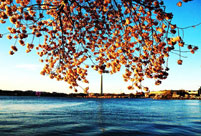 Cherry blossoms hit peak bloom in Washington D.C.
Cherry blossoms hit peak bloom in Washington D.C. Children in ancient costumes learn Zhusuan
Children in ancient costumes learn Zhusuan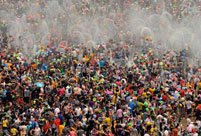 Tens of thousands celebrate Water Splashing Festival
Tens of thousands celebrate Water Splashing Festival A bite of China II whets the appetite
A bite of China II whets the appetite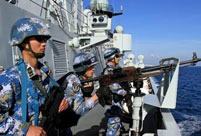 Chinese frigate completes its 14th escort mission
Chinese frigate completes its 14th escort mission Let's dance in wealthy Shaanxi
Let's dance in wealthy Shaanxi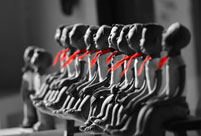 A date with 798: feel the art around you
A date with 798: feel the art around you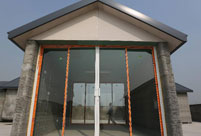 3D-printed houses built in Shanghai
3D-printed houses built in Shanghai The backstage of the Fashion Week
The backstage of the Fashion Week College students in Han costumes
College students in Han costumes Postgraduate works as waitress
Postgraduate works as waitress Life in a Lahu village in Yunnan
Life in a Lahu village in Yunnan An orphan’s wedding
An orphan’s wedding Hollywood documentary brings Diaoyu Islands truth to new audience
Hollywood documentary brings Diaoyu Islands truth to new audienceDay|Week|Month